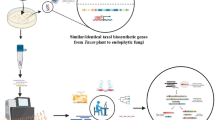Abstract
Objectives
To characterize a biosynthetic gene that is selectively involved in the biosynthesis of yellow or orange components in the azaphilone polyketide pathway of Monascus.
Results
A reductive modification is predicted to control the relative levels of reduced (yellow) and oxidized (orange and red) components in the pathway of azaphilone pigment biosynthesis in Monascus. Targeted inactivation of a reductase gene mppE enhanced orange and red pigment production whereas overexpression of the gene promoted yellow pigment production. The effect of mppE overexpression was dependent on culture methods, and augmented yellow pigmentation was evident in a submerged culture employing a chemically defined medium.
Conclusions
MppE controls the biosynthesis of the yellow pigments, ankaflavin and monascin, as a reductive enzyme in the azaphilone polyketide pathway.




Similar content being viewed by others
References
Balakrishnan B, Karki S, Chiu SH, Kim HJ, Suh JW, Nam B, Yoon YM, Chen CC, Kwon HJ (2013) Genetic localization and in vivo characterization of a Monascus azaphilone pigment biosynthetic gene cluster. Appl Microbiol Biotechnol 97:6337–6345
Balakrishnan B, Chen CC, Pan TM, Kwon HJ (2014a) Mpp7 controls regioselective Knoevenagel condensation during the biosynthesis of Monascus azaphilone pigments. Tetrahedron Lett 55:1640–1643
Balakrishnan B, Kim HJ, Suh JW, Chen CC, Liu KH, Park SH, Kwon HJ (2014b) Monascus azaphilone pigment biosynthesis employs a dedicated fatty acid synthase for short chain fatty acyl moieties. J Kor Soc Appl Biol Chem 57:191–196
Bijinu B, Suh JW, Park SH, Kwon HJ (2014) Delineating Monascus azaphilone pigment biosynthesis: oxidoreductive modifications determine the ring cyclization pattern in azaphilone biosynthesis. RSC Adv 4:59405–59408
de Groot MJ, Bundock P, Hooykaas PJ, Beijersbergen AG (1998) Agrobacterium tumefaciens-mediated transformation of filamentous fungi. Nat Biotechnol 16:839–842
Feng Y, Shao Y, Chen F (2012) Monascus pigments. Appl Microbiol Biotechnol 96:1421–1440
Hsu YW, Hsu LC, Liang YH, Kuo YH, Pan TM (2010) Monaphilones A−C, three new antiproliferative azaphilone derivatives from Monascus purpureus NTU 568. J Agric Food Chem 58:8211–8216
Jung H, Kim C, Kim K, Shin CS (2003) Color characteristics of Monascus pigments derived by fermentation with various amino acids. J Agric Food Chem 51:1302–1306
Kim JG, Choi YD, Chang YJ, Kim SU (2003) Genetic transformation of Monascus purpureus DSM1379. Biotechnol Lett 25:1509–1514
Manzoni M, Rollini M (2002) Biosynthesis and biotechnological production of statins by filamentous fungi and application of these cholesterol-lowering drugs. Appl Microbiol Biotechnol 58:555–564
Mapari SA, Thrane U, Meyer AS (2010) Fungal polyketide azaphilone pigments as future natural food colorants? Trends Biotechnol 28:300–307
Namiki F, Matsunaga M, Okuda M, Inoue I, Nishi K, Fujita Y, Tsuge T (2001) Mutation of an arginine biosynthesis gene causes reduced pathogenicity in Fusarium oxysporum f. sp. melonis. Mol Plant Microbe Interact 14:580–584
Ogihara J, Kato J, Oishi K, Fujimoto Y (2001) PP-R, 7-(2-hydroxyethyl)-monascorubramine, a red pigment produced in the mycelia of Penicillium sp. AZ. J Biosci Bioeng 91:44–47
Patakova P (2013) Monascus secondary metabolites: production and biological activity. J Ind Microbiol Biotechnol 40:169–181
Shi K, Chen G, Pistolozzi M, Xia F, Wu Z (2016) Improved analysis of Monascus pigments based on their pH-sensitive UV–vis absorption and reactivity properties. Food Addit Contam. doi:10.1080/19440049.2016.1214289
Wang TH, Lin TF (2007) Monascus rice products. Adv Food Nutr Res 53:123–159
Xie N, Liu Q, Chen F (2013) Deletion of pigR gene in Monascus ruber leads to loss of pigment production. Biotechnol Lett 35:1425–1432
Zabala AO, Xu W, Chooi YH, Tang Y (2012) Characterization of a silent azaphilone gene cluster from Aspergillus niger ATCC 1015 reveals a hydroxylation-mediated pyran-ring formation. Chem Biol 19:1049–1059
Acknowledgments
This research was supported by Basic Science Research Program through the National Research Foundation of Korea (NRF) funded by the Ministry of Education (NRF-2013R1A1A2059458 and NRF-2016R1D1A1B02009237).
Supporting information
Supplementary Table 1—Primers used.
Supplementary Fig. 1—LC-MS analysis for identification of MAz compounds in the extract.
Supplementary Fig. 2—Pigment content and profile of the organic extracts from PDB cultures.
Supplementary Fig. 3—Structures of the compounds other than 1–6.
Author information
Authors and Affiliations
Corresponding author
Electronic supplementary material
Below is the link to the electronic supplementary material.
Rights and permissions
About this article
Cite this article
Balakrishnan, B., Park, SH. & Kwon, HJ. A reductase gene mppE controls yellow component production in azaphilone polyketide pathway of Monascus . Biotechnol Lett 39, 163–169 (2017). https://doi.org/10.1007/s10529-016-2232-y
Received:
Accepted:
Published:
Issue Date:
DOI: https://doi.org/10.1007/s10529-016-2232-y




